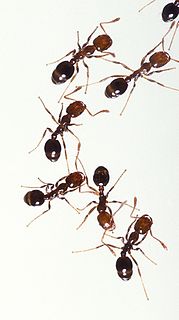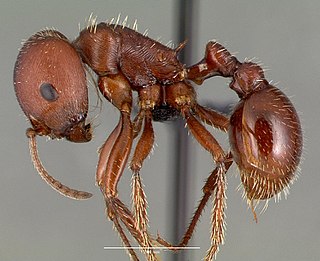
Ants are eusocial insects of the family Formicidae and, along with the related wasps and bees, belong to the order Hymenoptera. Ants appear in the fossil record across the globe in considerable diversity during the latest Early Cretaceous and early Late Cretaceous, suggesting an earlier origin. Ants evolved from vespoid wasp ancestors in the Cretaceous period, and diversified after the rise of flowering plants. More than 12,500 of an estimated total of 22,000 species have been classified. They are easily identified by their elbowed antennae and the distinctive node-like structure that forms their slender waists.

Fire ants are several species of ants in the genus Solenopsis. They are, however, only a minority in the genus, which includes over 200 species of Solenopsis worldwide. Solenopsis are stinging ants, and most of their common names reflect this, for example, ginger ants and tropical fire ants. Many species also are called red ants because of their light brown color, though species of ants in many other genera are similarly named for similar reasons. Examples include Myrmica rubra and Pogonomyrmex barbatus.

Aenictogiton is a genus of ants, comprising seven rarely collected species. All of the species are known only from males from Central Africa, and show a morphological and phylogenetic affinity to the army ant genus Dorylus. The dorylomorph ants include six subfamilies– Aenictogitoninae, Cerapachyinae, Leptanilloidinae, and the three army ant subfamilies Aenictinae, Dorylinae and Ecitoninae.

Pogonomyrmex is a genus of harvester ants, occurring primarily in the deserts of North, Central, and South America, with a single endemic species from Haiti.

The name army ant (or legionary ant or marabunta) is applied to over 200 ant species in different lineages. Due to their aggressive predatory foraging groups, known as "raids", a huge number of ants forage simultaneously over a limited area.

Dorymyrmex is a genus of ants in the subfamily Dolichoderinae.
Sphaeroseius ecitophilus is a South American species of mite.

Monomorium is a genus of ants in the subfamily Myrmicinae. As of 2013 it contains about 396 species. It is distributed around the world, with many species native to the Old World tropics. It is considered to be "one of the more important groups of ants," considering its widespread distribution, its diversity, and its variety of morphological and biological characteristics. It also includes several familiar pest species, such as the pharaoh ant and the flower ant.
Roy R. Snelling was an internationally renowned American entomologist who studied Hymenoptera, mainly ants, wasps and bees. He was the emeritus collections manager at the Natural History Museum of Los Angeles County where he worked for over 30 years, joining the museum in 1963 and retiring in 1993. He dedicated his professional life to making insect biodiversity better known and appreciated.

Procryptocerus is a Neotropical genus of gliding ants, with the ability to "parachute" by steering their fall if they drop off of the tree they're on.

Neivamyrmex is a genus of army ants in the subfamily Dorylinae. Most species are predominantly subterranean, but they will occasionally forage above ground at night or on cloudy days.

Metapone is an Old World genus of ants in the subfamily Myrmicinae. The genus is found in the Indo-Australian, Oriental and Malagasy regions. Most species are known only from a few specimens.

Mayriella is an Indo-Australian genus of ants in the subfamily Myrmicinae. Colonies in this genus are very small, typically consisting of 50 - 100 individuals.

Dorymyrmex lipan is a species of ant in the genus Dorymyrmex. Described by Snelling in 1995, the species is endemic to the United States and Mexico.

Dorymyrmex paiute is a species of ant in the genus Dorymyrmex. Described by Snelling in 1995, the species is endemic to the United States.

Neivamyrmex pilosus is a species of army ant in the family Formicidae.

Neivamyrmex texanus is a species of army ant in the family Formicidae.

Neivamyrmex opacithorax is a species of army ant in the family Formicidae.

Neivamyrmex swainsonii is a species of army ant in the family Formicidae.

















